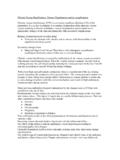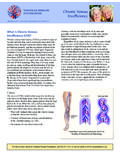Transcription of Treatment of Superficial Venous Disease of the Lower Leg
1 PRACTICE GUIDELINES. Superficial Venous Disease advancing vein care Treatment of Superficial Venous Disease of the Lower Leg Background The American College of Phlebology has prepared The diagnosis and Treatment of Venous Disease this white paper with the goal of creating a has advanced more in the last 10 years than in summation document that reflects the evidence- the previous 2 centuries combined. Ultrasound, based recommendations in the Gloviczki paper endovenous ablation devices, foam sclerotherapy as well as many other current studies. Other and tumescent anesthesia have greatly improved recommendations are based on American College patient care and have moved Treatment from the of Phlebology's consensus of experts where the operating room to the office or radiology suite. This evidence-based research is sparse, yet the therapy is has created challenges for insurers. Medical necessity considered standard of care.
2 Policy for the Treatment of chronic Venous Disease (CVD) has become fragmented and inconsistent We acknowledge that all carriers are free to across the among private insurers and Medicare. determine coverage guidelines, etc., based upon As with any medical specialty, those who are most their own independent review of the literature and committed to that specialty generally provide the best resources like Cochrane and others. However, we care. Commitment includes some form of training, suggest that evidence based medical necessity a practice focused in that area and continuing should not vary greatly based on geography or education through attendance at meetings and insurer. We would like to introduce the concept other CME. The American College of Phlebology of medically significant Venous insufficiency . (ACP) the American Venous Forum (AVF), the or evidence-based medical significance. This Society of Interventional Radiology (SIR) and other eliminates confusion around terms like cosmetic.
3 Organizations have been at the forefront of advancing or not medically necessary. The medical evidence education, research and appropriate Treatment of should determine the definition of medically Venous Disease . significant Venous insufficiency using a combination of CEAP and VCSS classifications (discussed below). In 2011, the Society for Vascular Surgery and the We would propose that payers retain the evidence- American Venous Forum undertook a comprehensive based definition of medical significance, but choose summary of all the available Venous research and at what level it becomes either a covered benefit . graded it by relevance and quality of data. Their or a non-covered benefit. Insurers could establish goal was to analyze all the available evidence-based different benefit levels for their various premium medicine and create rational guidelines for Treatment options. In this way, the evidence-based medical of Venous Disease of the Lower limbs and pelvis.
4 This criteria would still be consistent across the industry. review, by Gloviczki et al, was well received by the In the following pages are medical necessity medical community across specialties treating Venous guidelines in a summary format. Disease , as it built consensus over a variety of topics. Practice Guidelines: Superficial Venous Disease rev020316 1. These recommendations have been determined therapeutic procedure to the patient vs. the expected by the method suggested by the Grading of benefit. The words, we recommend, are used for Recommendations Assessment, Development and GRADE 1 strong recommendations if the benefits Evaluation system (GRADE) working group. (www. clearly outweigh risks and burdens, or vice versa; the ) words, we suggest, are used for GRADE 2 weak recommendations when the benefits are closely For each guideline, the letter A, B or C marks the balanced with risks and burdens.
5 Where current quality of current evidence as high, medium or low evidence is weak or lacking, the degree of consensus quality. The grade of recommendation of a guideline of the committee reflects the grade with the quality of can be strong (1) or weak (2), depending on the the recommendation adjusted accordingly. risk and burden of a particular diagnostic test or a Table I. Grading Recommendations According to Evidence Grade of Recommendation/ Benefit vs Risk and Burdens Methodologic Quality of Supporting Implications Description Evidence 1A. Strong recommendation, Benefits clearly outweigh risk RCTs without important limitations or Strong recommendation;. high-quality evidence and burdens, or vice versa overwhelming evidence from observa- can apply to most patients in tional studies most circumstances without reservation 1B. Strong recommendation, Benefits clearly outweigh risk RCTs with important limitations (in- Strong recommendation.)
6 Moderate quality evi- and burdens, or vice versa consistent results, methodologic flaws, can apply to most patients in dence indirect, or imprecise) or exceptionally most circumstances without strong evidence from observational reservation studies 1C. Strong recommendation, Benefits clearly outweigh risk Observational studies or case series Strong recommendation but low-quality or very low- and burdens, or vice versa may change when higher quality evidence quality evidence becomes available 2A. Weak recommendation, Benefits closely balanced with RCTs without important limitations or Weak recommendation; best high-quality evidence risks and burden overwhelming evidence from observa- action may differ depending on tional studies circumstances or patients' or societal values 2B. Weak recommendation, Benefits closely balanced with RCTs with important limitations (in- Weak recommendation; best moderate-quality risks and burden consistent results, methodologic flaws, action may differ depending on evidence indirect, or imprecise) or exceptionally circumstances or patients' or strong evidence from observational societal values studies 2C.
7 Weak recommendation, Uncertainty in the estimates Observational studies or case series Very weak recommendations;. low-quality or very low- of benefits, risks, and burden; other alternatives may be quality evidence benefits, risk, and burden may equally reasonable be closely balanced Practice Guidelines: Superficial Venous Disease rev020316 2. Summary of Guidelines for Treatment Superficial phlebitis, stasis dermatitis or ulceration. We recommend patients should be evaluated using of Venous Disease the CEAP classification and the Venous Clinical Indications for Treatment Severity Score (VCSS). We would define medically Compression therapy is an effective method for necessary as a CEAP classification of C2 or higher. the management of symptoms related to Superficial GRADE 1A (1). Disease but it does not correct the source of reflux. When patients have a correctable source of reflux definitive Treatment should also be offered unless it is In addition contraindicated or unwanted.
8 GRADE 1A (1,8,9,10,11) We recommend all patients being considered for Treatment must have a duplex ultrasound of We recommend against compression therapy as a the Superficial Venous system and, at a minimum, prerequisite therapy for symptomatic evaluation of the common femoral vein and popliteal Venous reflux Disease when other definitive vein for patency and competence. The exam should treatments such as endovenous ablation are ideally be done in the standing position. GRADE 1A. appropriate. GRADE 1A (1,8,9,10,11) (1,3,4,5,6). After interventional Treatment , we recommend the We suggest all noninvasive vascular diagnostic use of a compression garment in the postoperative studies be per formed by a qualified physician or by a period. There is extra benefit to the patient in the qualified technologist under the general supervision form of reduced pain after use of compression. The of a qualified physician.
9 GRADE 1C (2). compression dosage and duration is at the discretion and clinical judgment of the treating physician. We recommend that named veins (Great GRADE 2B Saphenous Vein (GSV), Small Saphenous Vein (SSV), Anterior Accessory of the Great Saphenous Superficial Venous insufficiency is a chronic Disease Vein (AAGSV), Posterior Accessory of the Great and as such we recommend that patients with Saphenous Vein (PAGSV ), Intersaphenous Vein this Disease be counseled to wear a compression (Vein of Giacomini)) must have a reflux time > 500. garment even after definite Treatment has been msec, regardless of the reported vein diameter. provided. The compression dosage is at the GRADE 1A (1,7,6). discretion and clinical judgment of the treating physician GRADE 2C Treatment of Named Saphenous Veins We recommend endovenous thermal ablation (laser We suggest the Treatment of some CEAP C2 patients and radiofrequency) is the preferred Treatment for with isolated varices, by medical compression hose saphenous and accessory saphenous (GSV, SSV, alone may be an acceptable form of Treatment .)
10 AAGSV, PAGSV) vein incompetence. GRADE 1B (1,15). A short 1-2 week trial of compression hose may be appropriate where an alternative etiology of We suggest Mechanical/chemical ablation (Clarivein symptoms is considered, musculoskeletal pain Device) may also be used to treat truncal Venous or neuropathy (spinal stenosis, sciatica, hip or knee reflux. GRADE 2B (2). arthritis, diabetic neuropathy etc). GRADE 2C. (2,8,9,10,11) We recommend open surgery is appropriate in veins not amenable to endovenous procedures but Indications for Treatment include pain or other otherwise is not recommended because of increased discomfort (ie, aching, heaviness, fatigue, soreness, pain, convalescent time, and morbidity. GRADE 1B (1). burning), edema, varix hemorrhage, recurrent Practice Guidelines: Superficial Venous Disease rev020316 3. We suggest when open surgery of the great We recommend (non visible) symptomatic tributary saphenous vein is performed it should include high veins be treated by ultrasound-guided liquid ligation and invagination stripping to the level of the sclerotherapy or foam chemical ablation.


